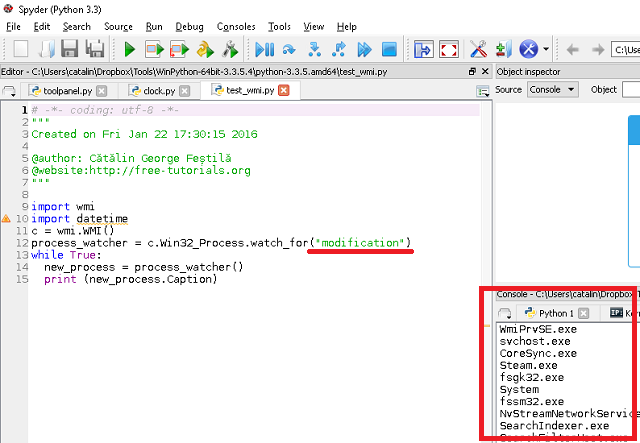Many python users use the Spyder IDE.
This IDE comes with many features and is easy to use, see Wikipedia page:
Spyder (formerly Pydee[3]) is an open-source cross-platform integrated development environment (IDE) for scientific programming in the Python language. Spyder integrates NumPy, SciPy, Matplotlib and IPython, as well as other open source software.[4][5] It is released under the MIT license.[6]
Six days ago, a release of this IDE with version 3.2.7 was announced.
This IDE can be download from GitHub page.
Is a blog about python programming language. You can see my work with python programming language, tutorials and news.
Showing posts with label Spyder. Show all posts
Showing posts with label Spyder. Show all posts
Saturday, March 3, 2018
Saturday, January 23, 2016
wmi python module - part 002.
According to MSDN Microsoft the Win32_Process WMI class represents a process on an operating system.
We can see all of the inherited properties of processes:
We can see all of the inherited properties of processes:
class Win32_Process : CIM_Process
{
string Caption;
string CommandLine;
string CreationClassName;
datetime CreationDate;
string CSCreationClassName;
string CSName;
string Description;
string ExecutablePath;
uint16 ExecutionState;
string Handle;
uint32 HandleCount;
datetime InstallDate;
uint64 KernelModeTime;
uint32 MaximumWorkingSetSize;
uint32 MinimumWorkingSetSize;
string Name;
string OSCreationClassName;
string OSName;
uint64 OtherOperationCount;
uint64 OtherTransferCount;
uint32 PageFaults;
uint32 PageFileUsage;
uint32 ParentProcessId;
uint32 PeakPageFileUsage;
uint64 PeakVirtualSize;
uint32 PeakWorkingSetSize;
uint32 Priority = NULL;
uint64 PrivatePageCount;
uint32 ProcessId;
uint32 QuotaNonPagedPoolUsage;
uint32 QuotaPagedPoolUsage;
uint32 QuotaPeakNonPagedPoolUsage;
uint32 QuotaPeakPagedPoolUsage;
uint64 ReadOperationCount;
uint64 ReadTransferCount;
uint32 SessionId;
string Status;
datetime TerminationDate;
uint32 ThreadCount;
uint64 UserModeTime;
uint64 VirtualSize;
string WindowsVersion;
uint64 WorkingSetSize;
uint64 WriteOperationCount;
uint64 WriteTransferCount;
}; import wmi
c = wmi.WMI()
for process in c.Win32_Process ():
name = process.Properties_("Name").Value
pid = process.Properties_('ProcessID').Value
parent = process.Properties_('ParentProcessId')
termination = process.Properties_('TerminationDate')
print (name,' = pid -',pid,'+', parent,'|termination_date-',termination) firefox.exe = pid - 13788 + 2564 |termination_date- None
explorer.exe = pid - 1048 + 772 |termination_date- None
sublime_text.exe = pid - 11404 + 2564 |termination_date- None
plugin_host.exe = pid - 7432 + 11404 |termination_date- None
cmd.exe = pid - 9568 + 2564 |termination_date- None
conhost.exe = pid - 14124 + 9568 |termination_date- None
conhost.exe = pid - 9700 + 11208 |termination_date- None
Taskmgr.exe = pid - 9424 + 13404 |termination_date- None
WmiPrvSE.exe = pid - 9764 + 772 |termination_date- None
SpfService64.exe = pid - 11908 + 684 |termination_date- None
python.exe = pid - 1308 + 9568 |termination_date- None
Posted by
Cătălin George Feștilă
Labels:
2016,
module,
python,
python 3,
python modules,
Spyder,
tutorial,
tutorials,
wmi
Friday, January 22, 2016
wmi python module - part 001.
Named WMI from Windows Management Instrumentation, this python module allow you to use Microsoft’s implementation of Web-Based Enterprise Management ( WBEM ).
Is a set of extensions to the Windows Driver Model AND that provides an operating system interface.
allows you to scripting languages like VBScript to manage Microsoft Windows personal computers and servers, both locally and remotely.
You cand read about this python module here.
Let try first example :
Now let's see another example can used by you with wmi python module.
This example let you see your processes.
I used the python version 3.3.5 and Spyder ( Scientific PYthon Development EnviRonment ) to test the script.
You can change .watch_for method args with: creation, deletion, modification or operation.

Is a set of extensions to the Windows Driver Model AND that provides an operating system interface.
allows you to scripting languages like VBScript to manage Microsoft Windows personal computers and servers, both locally and remotely.
You cand read about this python module here.
C:\Python34\Scripts>pip install wmi
...
Installing collected packages: wmi
Running setup.py install for wmi
warning: install_data: setup script did not provide a directory for 'readme.
txt' -- installing right in 'C:\Python34'
...
Successfully installed wmi
Cleaning up... Let try first example :
C:\Python34>python
Python 3.4.1 (v3.4.1:c0e311e010fc, May 18 2014, 10:45:13) [MSC v.1600 64 bit (AM
D64)] on win32
Type "help", "copyright", "credits" or "license" for more information.
>>> import wmi
>>> remote_process = wmi.WMI (computer="home").new ("Win32_Process")
>>> for i in wmi.WMI ().Win32_OperatingSystem ():
... print (i.Caption)
...
Microsoft Windows 10 Home Now let's see another example can used by you with wmi python module.
This example let you see your processes.
import wmi
import datetime
c = wmi.WMI()
process_watcher = c.Win32_Process.watch_for("modification")
while True:
new_process = process_watcher()
print (new_process.Caption) I used the python version 3.3.5 and Spyder ( Scientific PYthon Development EnviRonment ) to test the script.
You can change .watch_for method args with: creation, deletion, modification or operation.

Posted by
Cătălin George Feștilă
Labels:
2016,
module,
python,
python 3,
python modules,
Spyder,
tutorial,
tutorials,
wmi
Subscribe to:
Comments (Atom)